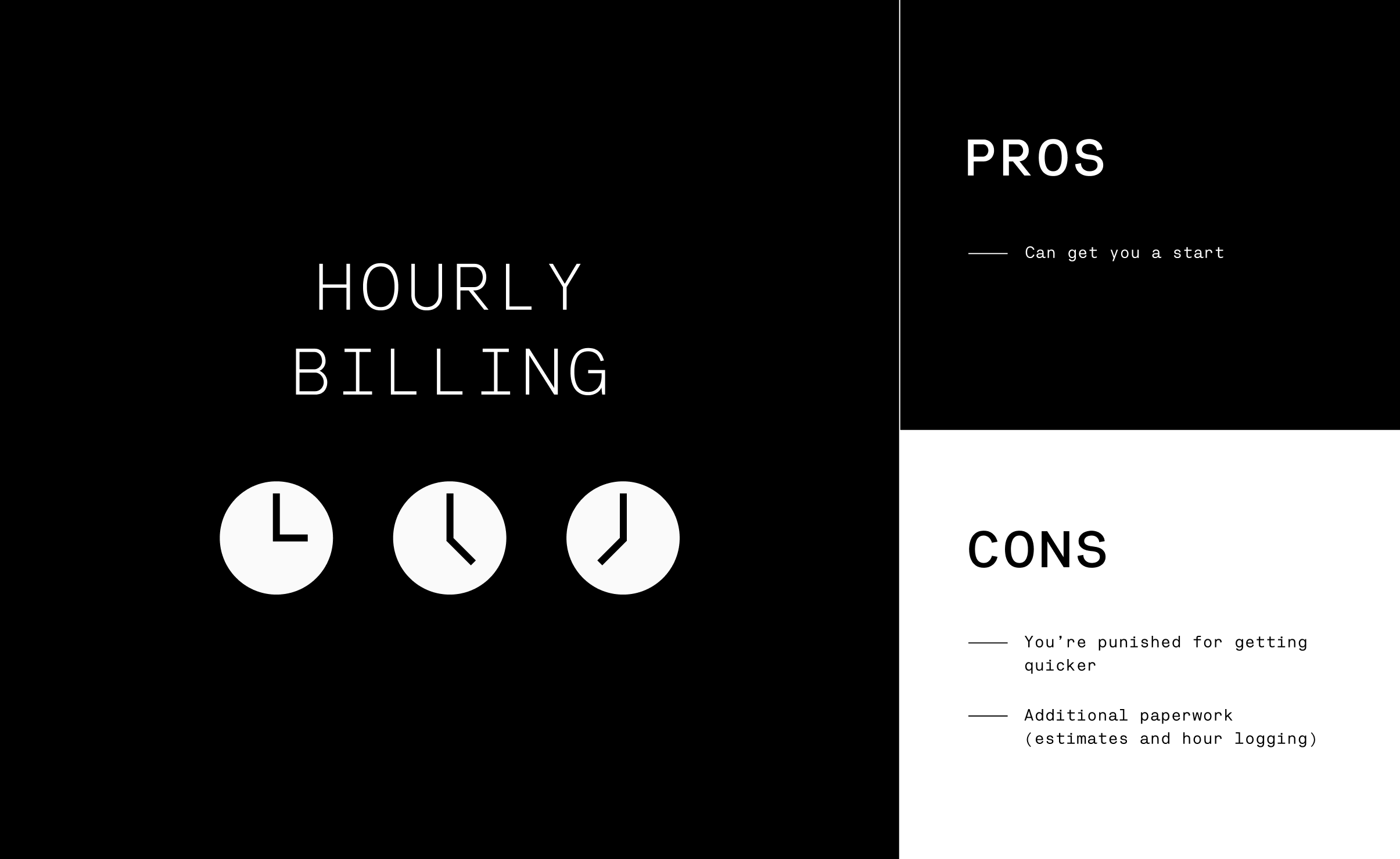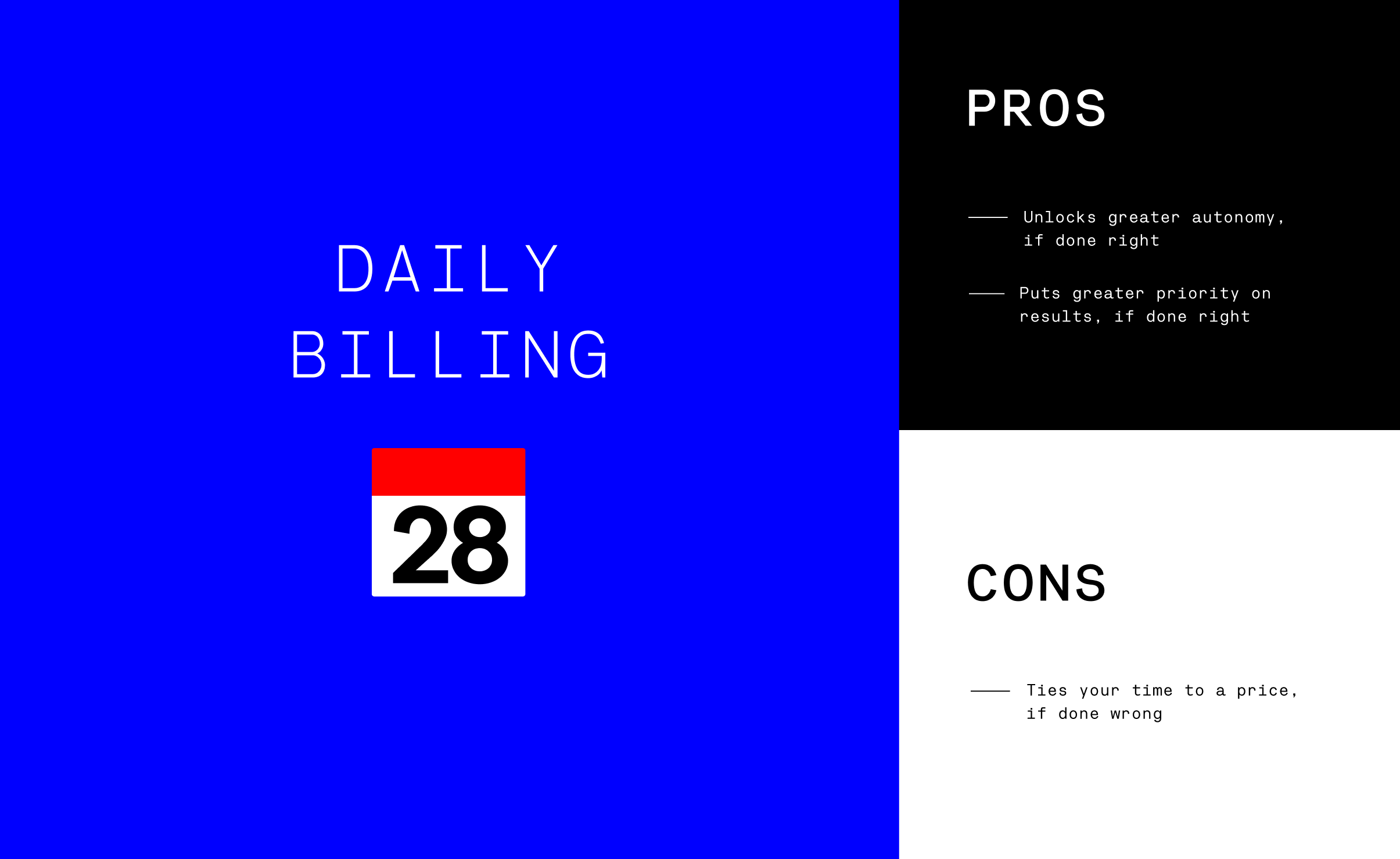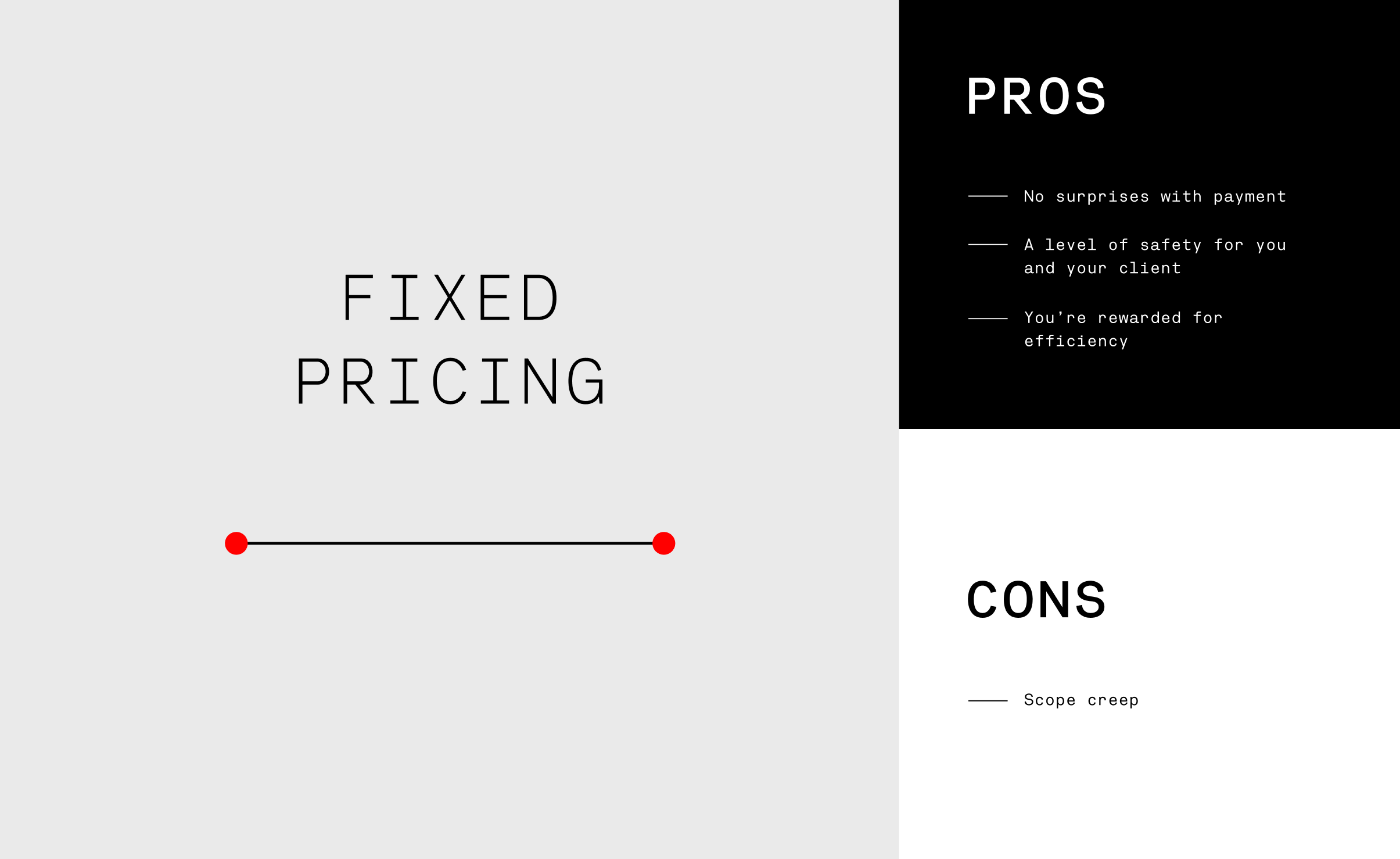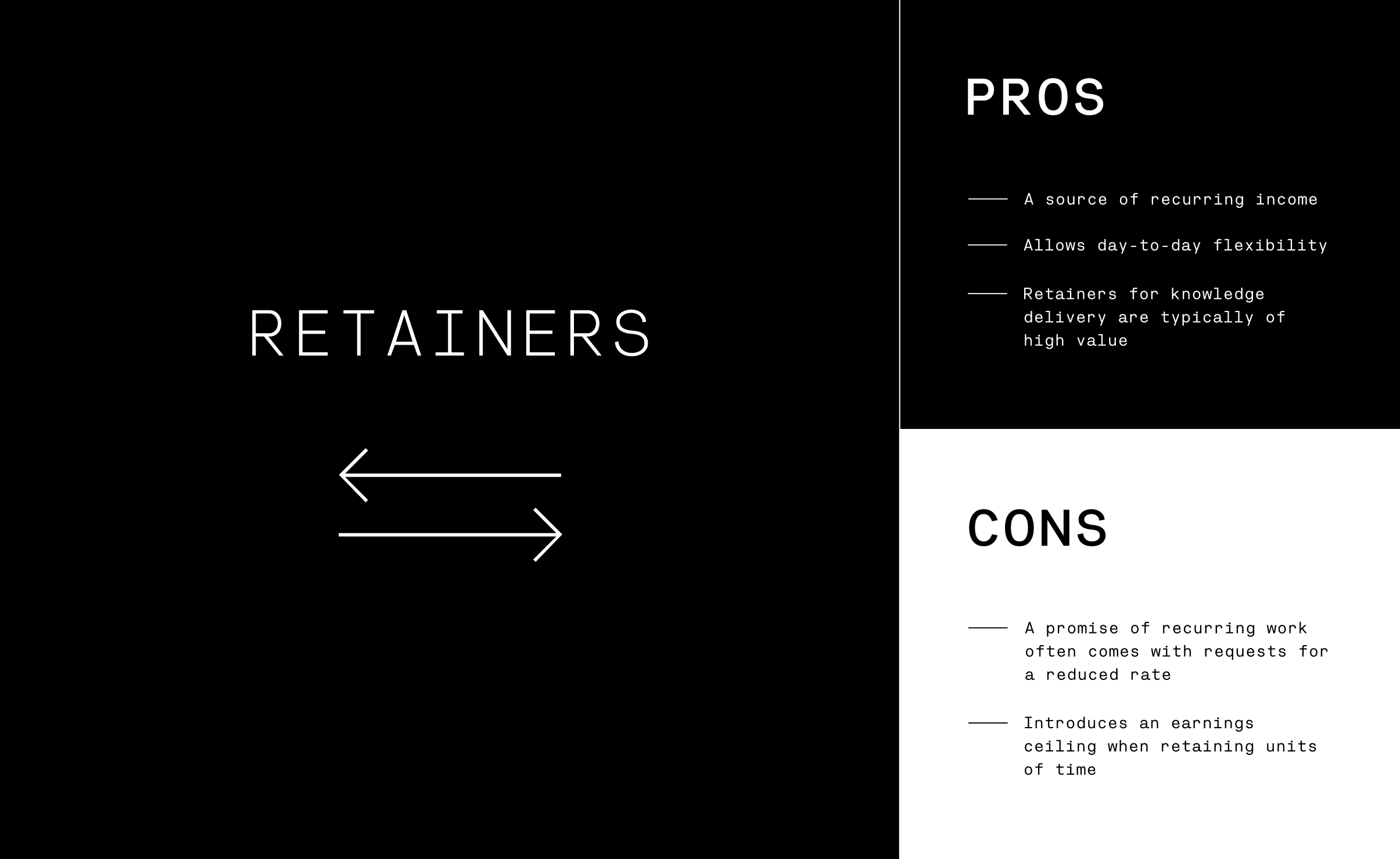You’re a freelance designer. Your core capabilities are solid, you navigate software well, you have a good eye. You produce results for people across multiple mediums. Your skills have been honed and your work is your art. But you feel that you don’t get paid what you’re worth.
I get it. As a freelancer in any field, knowing what to charge is tricky.
The good news is, by making pricing a topic of priority, you can use it to help better portray your true value to people.
Alongside the art of design, seek to understand the art of pricing to get paid what you’re worth.
The problem
The problem with pricing freelance work is that there are an often overwhelming number of ways to do it:
- Hourly billing
- Daily billing
- Fixed pricing
- Value-based pricing
- Retainers
You’ll likely have heard of them all. Perhaps you’ve had experience with applying one or two of them. But which one’s the best? Which pricing strategy should you use when billing your client for work? Herein lies another problem.
The methodology to use will depend on multiple factors:
- What the work is
- How long it might take
- What your position is
- Who your client is
- How much you need the job
There’s too much variability to declare a singular route as the winner for every freelancer and every project. These issues highlight pricing as an art form as opposed to an exact science.
Pricing is personal.
"Attributing yourself to one pricing method across the board isn’t always the best approach to getting deals over the line."
The fallacy
One person will tell you “hourly billing should generally be avoided” and another that “retainers are a great way to secure recurring revenue,” without clarifying or expanding on it.
While I agree with these statements, you can’t blindly apply this knowledge to every engagement that comes your way. This brings to the forefront why freelancers find pricing so difficult: there’s no one-size-fits-all solution. The idea that you can apply one pricing strategy to every freelance project in an attempt to maximize profit, for the length of your career, is, in my experience, impractical.
I don’t doubt that some people choose one pricing methodology, stick to it and are incredibly successful. There are always exceptions. But this isn’t always realistic, especially when starting out. I know I couldn’t afford to be so selective with my first client. It was only once I raised my value that I could start to exert more of my pricing preferences.
Even as a new freelancer, there are still certain pricing methodologies that suit certain projects. Attributing yourself to one pricing method across the board isn’t always the best approach to getting deals over the line.
There’s more to it than that.
Pricing is fluid.
"Price mirrors risk. Because you present as the least risky option, you can charge a premium for your work."
The reality
Value is the true constant that informs price. I’m not just talking about value-based pricing. Whatever pricing strategy you use, it should be based on value.
What do people perceive your value to be? In over a decade of freelancing, this question has informed many of the prices I’ve given.
I mentioned earlier that pricing is personal. This couldn’t be truer when giving and receiving prices for freelance work. When you present yourself as a jack-of-all-trades designer offering branding, web design, print design, UX, UI and illustration, is it really perceivable to a prospect that you can produce high-value work in all of these fields?
When you position yourself like this as a freelancer, you’re often seen as a commodity service provider as opposed to a specialist service producer. And the latter is commonly seen as someone who can provide greater value.
So because pricing is personal, you need differentiators that increase your value:
- A specialism in service
- A highly individual style
- Credibility within your wider industry
- Excellent soft-skills
- An attractive personality
If you’re the stand-out freelancer, you become the safe bet in the eyes of clients searching for services. Price mirrors risk. Because you present as the least risky option, you can charge a premium for your work.
When a client can’t see the difference between your service and someone else’s, your chances of charging a premium for individuality are low.
When you’re the obvious choice, your value is high and so are your chances of getting paid in line with this. Your perceived value forms the basis of the art of pricing your freelance services.
From here, choose the most appropriate strategy for the task at hand and your current circumstances.
Are you looking to get your foot in the door? Be aware that your choice of terms may be limited.
You might want to avoid hourly billing, but are you in a position to blanketly reject that right now? Your play here would be to get an initial agreement, prove yourself to be indispensable and renegotiate to more preferential terms soon after.
Do you want to stick to fix-priced projects only? There’s always a client who comes along with an iterative project that they can’t fix the scope for.
Paid discovery can work to solve this, but when you can get started quickly and achieve a top-end day rate as an alternative, does it make sense to skip the engagement if they don’t go for that?
The reality of pricing is that there’s more than the price at play. It will benefit you as a freelancer to:
- Understand a range of pricing strategies
- Gauge the value of your service to people individually
- Take an honest overview of your current circumstances
These all make up a part of the art.
Pricing has layers.
"It’s more important to get started than to never start based on terms."
The Solution
How does a freelance designer solve the pricing matrix? Start with the methodologies:

Hourly Billing
When you bill by the hour, you’re punished for getting quicker. There is no incentive to do things efficiently as doing so directly reduces the amount of money you’ll earn.
Hourly billing also comes with additional paperwork in the form of estimates and hour logging. Which, quite frankly, isn’t always the best use of your time.
If you want to use efficiency as a tool to maximize your earning potential as a freelancer, hourly billing is generally not the way to go. Directly tying a unit of your time to a price caps your earning potential. There are only so many hours available in the day.
But it’d be naive of me to say that there aren’t outliers in this scenario. You might command an uncommonly huge hourly rate and only wish to work four hours per day, for instance.
Equally, it’s important to consider your current position in the market. Hourly billing might be a way to get a chance. It’s more important to get started than to never start based on terms.
If you do use hourly billing to gain a foothold, have the goal to stop using it as soon as you can. Make yourself indispensable to your current hourly client and build an audience of other people willing to hire you. This will give you the leverage to move toward more preferred methods of pricing projects.
"If results are being delivered, does it really matter exactly how many hours and minutes are logged each day?"

Daily Billing
Freelancers can approach daily billing in two different ways. I’ve found one to be more effective, in terms of getting paid what you’re worth, than the other.
It’s common to assume that when you give a price for a day’s work, that equates to 7/8 hours of your time. Clients will then assume that your day rate / hours worked = your hourly rate, and you’re no better off than when you started billing hourly. In fact, you’re worse off because a day rate is typically given at a lower price than if you were to bill the same amount of hours individually. As with hourly billing, daily billing in this guise shares all the downsides.
The alternative is to price a day as a day, and not a number of guaranteed hours. Providing you’re clear with your collaborator, this is how you unlock more autonomy. If you want to work an hour less one day and an extra hour the following day, for example, then you can.
The point here is that if results are being delivered, does it really matter exactly how many hours and minutes are logged each day?
In either fashion, you’re still tying a unit of your time to a price, which comes with its negatives. But it can work well. Especially in instances where the day rate is high and the work you’re doing is particularly difficult to scope.

Fixed-Pricing
In my experience pricing freelance work, fixed-price terms are nearly always the best. When you give a fixed-price for a piece of work, you know exactly what you’ll get paid and your client knows exactly what they’ll pay for it. There’s a level of safety in a fixed-price for both parties.
However, you need a watertight scope.
Scope creep is frustrating and costly for a freelancer. Make sure that whenever you give a fixed-price for a body of work, it is clearly briefed and agreed upon by both parties. Be clear that any work outside of this comes at an additional cost.
Another rule to follow when working to a fixed price is to get a deposit. You can’t be fully sure that you have someone’s commitment to a project unless money has exchanged hands.
The key benefit to fixed-pricing is the converse of hourly billing: you are directly rewarded for efficiency. The better you get at performing your skill, the quicker you’ll get. And the quicker you’ll get, the more you’ll get paid in less time. The paramount thing here is to always retain quality, thus preserving your perceived value.

Value-Based Pricing
Value-based pricing is similar to fixed-pricing in its delivery; it’s a set price for a set body of work.
However, there’s one big difference: The figure that you present is wholly based on the value of the business outcomes of the project. The price that you give is usually a percentage, which can be justified as fair based on quantifiable metrics.
Here’s a short and simplified example:
Your client's average lead value = $500
You estimate that your work will get them 100 leads in year 1. That's $50,000 of value.
You give a price for your work based on a % of that figure.
If you can show the value, you can justify the price.
Although this differs from country to country, the problem with value-based pricing is that it’s often a tough sell. Because it can be a tough sell, the effort involved to do the research can often be quite costly.
The key to using value-based pricing is to gauge, on a per-client basis, how presenting a proposal with this method will go down. It takes much research to uncover the information that you need, and if you’re doing a lot of leg work for a client who won’t receive a value-based proposal well, it’s wasted time and energy.
Value-based pricing is more well-received when presenting to prospects who have significantly more money than they have time. If you’re speaking with someone who does not see the value in hiring you as an individual, other than another service provider, a value-based price will often fall flat.

Retainers
When you work well with a client and they’re happy with the results you’re providing, a typical route forward is to bump up your level of involvement. Retainer agreements, in this scenario, provide a level of safety for both the client and freelancer. It’s guaranteed work for the client and guaranteed income for the freelancer.
But naturally, there are pros and cons to retainers too.
With the uptick in guaranteed work, often comes with the expectation of a reduced rate. This has always felt wrong to me as it assumes that you have a problem selling your services. When you reduce your rate in this instance, you reduce your perceived value to the client.
A major benefit, on the other hand, is that you can sell a chunk of your availability and spread out your involvement throughout the month, which allows you more day to day flexibility.
Ultimately, for the long term growth of your freelancing business, place a priority on those retainers that give your availability to deliver knowledge, not direct labor. Direct labor is often linked back to time, and as with hourly billing, your earnings ceiling becomes limited.
When you deliver knowledge through a strategy engagement for instance, there is no limit on what the value you add to the project is worth.
Look to study all of these pricing methodologies, and create a list of preferences that suit the work that you do and your current position. Form a short-term approach that helps you arrive at your long-term, ideal pricing strategy. Charging by the day initially may lead you to a high-value ongoing strategic retainer, for instance.
Apply methods where appropriate.
"Giving a price without researching your prospect is a sure-fire way to give the wrong one."
No matter which methodology you choose, use value to price
You don’t have to use value-based pricing to take value into consideration when giving a price for work.
Understand your value metrics:
- Individuality
- Credibility
- Availability
- Risk reduction
- Results provision
- Price itself
Take time to understand what your overall value is compared to others in your field. Look into the worth of the results your services create on a client-by-client basis. Before giving any price, ask yourself this question:
“How much am I worth to this project?”
Knowing your worth better informs price.
Research your prospect
Giving a price without researching your prospect is a sure-fire way to give the wrong one.
You need to know who you’re potentially going to be working with: Can they afford your services? How large of a business do they have? Have they worked with freelancers before? Do they want to work with you specifically or do they just want the job done?
Know your client to guide your price.
Acknowledge your current position
How’s your cash flow?
Are you just starting out?
Are you a few years in?
Have you been a designer for a very long time?
Are you new to your industry or do people know of your work? What’s the current demand for people who offer your service? Be aware of where you are to help you make the right offers.
In conclusion
Pricing can form a barrier to entry for many budding freelancers. It’s a skill in itself that designers who are looking to go it alone must learn. No one can tell you it’s easy.
What I can tell you is that it becomes easier with research, practice and time. Each book you read, article you absorb, mentor you speak with and project you offer on, brings you closer to becoming better at pricing your work.
There’s no magic formula that will help you decipher pricing forever. Nonetheless, you can give yourself the best chance of getting paid what you’re worth through a focus on value.
Pricing can’t always be solved by science alone.
Pricing is an art.
You can learn more on this topic from Tom in his book, "Pricing Freelance Projects."















